John Wallis Titt
John Wallis Titt (1841–1910) was a late nineteenth-century English mechanical engineer and builder of a particular design of large wind engine.
John Wallis Titt | |
|---|---|
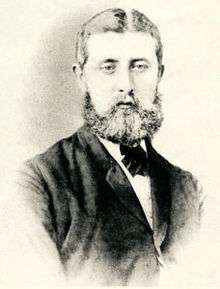 John Wallis Titt | |
| Born | 1841 |
| Died | 1910 |
| Nationality | English |
| Occupation | Engineer |
| Children | Two sons |
| Parent(s) | John Titt Eliza Titt (Née Wallis) |
| Engineering career | |
| Discipline | Agricultural engineering, wind engines |
| Practice name | Woodcock Ironworks, Warminster |
Early life
Titt was born in 1841 at Elm Farm, Chitterne, Wiltshire to John Titt and Eliza Titt (née Wallis).[1] The farm had a post mill, which he worked for his father until he left in 1865 to join Messrs Wallis, Haslan and Stevens, agricultural engineers and steam engine manufacturers of Basingstoke, Hampshire. Titt worked for them for two years as a commercial traveller. In 1867, he joined the millwrighting firm of Brown & May, based in Devizes, Wiltshire. He remained with them for five years.[2] From 1870, Titt was an agent for Brown and May.[3]
Later life
In 1872, Titt established himself at Portway, Devizes as an agricultural engineer, employed by Brown & May. He was also an agent for Messrs Fowler's of Leeds, Yorkshire. In 1874 he entered business on his own account[3] and in 1876 he established the Woodcock Ironworks at Warminster. At first, he manufactured elevators. Titt continued in business as an agricultural engineer and iron founder. In 1884, Titt manufactured his first wind engine, for the Boyton estate. Titt continued to run the firm until he retired through ill health in 1903, the year in which he exhibited three wind engines at the Royal Agricultural Society's show, Park Royal, London. He died in May 1910.[2]
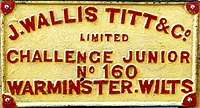
After his death, the firm was run by his two sons.[1] At its peak, 150 people were employed.[3] Apart from the agricultural side of the business, the firm also handled bicycles and motor cars.[1] The firm declined until in 1929 only 25 people were employed. In the 1940s, under the management of G. T. Frost, the firm expanded again, employing 60 people in 1952.[3] A branch was established at Frome, Somerset.[4] The Warminster headquarters closed in 1986[4] but the firm continued in business in Frome until 2009.[1]
Titt wind engines
Titt made three main types of wind engine: the Woodcock, Simplex direct and the Simplex geared. After the firm was taken over by his sons, another standard type of windpump, the Imperial, was produced.[2]
Woodcock engines
The Woodcock engine was a conventional iron windpump. It came in two sizes, with wind wheels of 10 feet (3.05 m) and 12 feet (3.66 m) and could be supplied with a wood or steel tower. The Woodcock wind engine could pump water to a total height of 150 feet (45.72 m).[2]
Simplex direct engines
The Simplex engines came either as direct drive or geared drive. The direct drive engines had a wind wheel diameter of 14 feet (4.27 m), 16 feet (4.88 m), 18 feet (5.49 m), 20 feet (6.10 m) and 25 feet (7.62 m). A 25 feet (7.62 m) high tower was supplied as standard, but could be made to any height a customer desired at extra cost. The blades of the wind wheel were similar in design and operation to the shutters on a Spring or Patent sail. Some of the larger direct engines were turned to wind by a fantail. A single or double fantail could be had, per the customer's wishes.[2]
Simplex geared engines
The geared engines came in the same sizes as the direct engines, and were also available in 30 feet (9.14 m), 35 feet (10.67 m) and 40 feet (12.19 m) diameter. A 25 feet (7.62 m) tower was standard for the smallest three sizes and the largere sizes came with a 35 feet (10.67 m) as standard. Again, a taller tower could be supplied at extra cost. The geared Simplex engines were turned into wind by a fantail.[2]
Locations
Two remaining wind engines made by John Wallis Titt are on show at the Wind Energy Museum in Repps with Bastwick, Norfolk.[5]
Titt wind engines are known to have been built at the following locations:-[2] unless otherwise indicated
| Location | Type | Notes |
|---|---|---|
| Almondsbury, Gloucestershire | Erected c1894 for the Cattybrook Brick Co Ltd. | |
| Amesbury, Wiltshire | A wind engine was erected at Amesbury Junction for the London and South Western Railway.[6] | |
| Barrowby, Lincolnshire | Erected by 1899 for the Duke of Devonshire. | |
| Basingstoke, Hampshire | Erected in 1898 at Pitt Hall Farm, Upper Wooton. | |
| Bentworth, Hampshire | Simplex | A wind engine was erected in 1901 at Bentworth and Lasham station on the Basingstoke and Alton Light Railway.[7] It is present on a photo of the station dated 1928, just visible behind the station building. |
| Bitterne, Hampshire | Erected at Thornhill Park in 1894. | |
| Boyton, Wiltshire | First wind engine supplied by Titt in 1884. | |
| Bridgwater, Somerset | Erected in 1893 at Stowey Farm. | |
| Broome, Shropshire | Erected in 1895 at Broome Station for the London and North Western Railway. | |
| Burderop, Wiltshire | Erected by 1899 on the Burderop Estate for Lt-Col Calley. | |
| Burnham-on-Sea, Somerset | Erected for Holt Bros, Burnham Brewery by 1894. | |
| Bury St Edmunds, Suffolk | Simplex wind engine driving chain pumps. | Erected in 1898 for Bury St Edmunds Town Council at a sewerage works in the town. |
| Bury St Edmunds, Suffolk | 40 feet (12.19 m) geared Simplex wind engine on a 35 feet (10.67 m) steel tower, itself erected on a 22 feet 6 inches (6.86 m) brick tower. | The largest Titt engine to date when built. The overall height of the engine was 81 feet (24.69 m). The 50 sails were 12 feet (3.66 m) long, tapering from 2 feet 6 inches (760 mm) at the tip to 1 foot (300 mm) at the heel. Equipped with twin fantails. Supplied the town with water. Proposal in 1900 to adapt it to generate electricity too. |
| Calne, Wiltshire | Erected by 1900 at Bowood House for the Marquess of Lansdowne. | |
| Castletown, Isle of Man | Erected in May 1892, replaced a steam engine. | |
| Chesfield, Hertfordshire | Erected at Chesfield Park by 1896. Supplied water from a well 300 feet (91.44 m) deep to a 2,000 imperial gallons (9,100 l) tank. | |
| Chitterne, Wiltshire | Woodcock[8] | Erected at Manor Farm in 1905, standing 1936.[8] |
| Cliddesden, Hampshire | Simplex | A wind engine was erected in 1901 at Cliddesden railway station on the Basingstoke and Alton Light Railway. It was demolished in the late 1940s.[7] The wind engine can be seen briefly in the film Oh, Mr Porter![6] |
| Codford St. Mary, Wiltshire | Erected by 1893. | |
| Cookham, Berkshire | 20 feet (6.10 m) geared Simplex on 40 feet (12.19 m) hexagonal tower. | Powered a chaff cutter, corn grinder, oat crusher and peat moss breaker. Erected at Sutton Farm for F D Lambert by 1894. |
| Croscombe, Somerset | 18 feet (5.49 m) Simplex | Erected in 1899 for Shepton Mallett Rural District Council. Used a 4-inch (100 mm) double suction pump to pump water to a height of 84 feet (25.60 m). |
| Crux Easton, Hampshire SU 4258 5642 |
20 feet (6.10 m) Simplex geared wind engine on a 32 feet (9.75 m)[9] hexagonal steel tower | 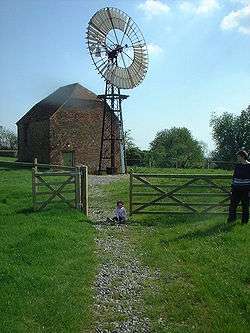 |
| Dover, Kent | Erected at the Infectious Diseases Hospital by 1893 for Dover Corporation. | |
| Dunwich, Suffolk | Erected by 1895 for the Grey Friars. | |
| Dursley, Gloucestershire | Erected by 1901 at Cam Mills. | |
| Dursley, Gloucestershire | 16 feet (4.88 m) Simplex on a 60 feet (18.29 m) steel tower. | Erected in 1898. Supplied over thirty properties in Dursley with water. Reservoir was 300 yards (270 m) from the wind engine. |
| Elsenham, Essex | Simplex | Drove an oat crusher in addition to pumping water. Erected for Walter Gilbey. |
| Faringdon, Berkshire | Erected by 1900 at Royal Prize Farm, Wadley House. | |
| Foxhill, Wanborough, Wiltshire | Erected by 1896. | |
| Gillingham, Dorset | Simplex wind engine on a brick water tower. | Erected at The Kendalls by 1895. |
| Glastonbury, Somerset | Supplied water to The Elms. Erected by 1892. | |
| Great Brington, Northamptonshire | 30 feet (9.14 m) diameter Simplex geared wind engine. | Supplied Great Brington and Little Brington with water from a well 202 feet (61.57 m) deep. Capacity 40,000 imperial gallons (180,000 l) per day. Erected for Earl Spencer by 1894. |
| Heytesbury, Wiltshire | Erected by 1893 on the Tytherington Estate. Supplied water to a reservoir 3⁄4 mile (1,207 m) away. Water raised a total of 260 feet (79.25 m) in height. | |
| Heytesbury, Wiltshire | Erected in 1895 at Bolesbro' Knoll for Lord Heytesbury. | |
| Highworth, Wiltshire | Erected by 1898 at Hannington Hall. Supplied water to the house, farm and stables. | |
| Hinton Charterhouse, Somerset | 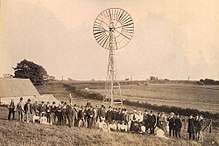 | |
| Hundon, Suffolk | Simplex on hexagonal steel tower | 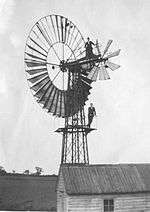 |
| Knighton, Leicestershire | Erected at Narborough Wood Farm by 1896. | |
| Leiston, Suffolk | Erected by 1892. | |
| Leiston, Suffolk | 16 feet (4.88 m) Simplex[10] | Erected in 1924 on the site of a smock mill. Standing in 1979. |
| Leiston, Suffolk | Erected by 1891 for C P Ogilvie. Supplied Sizewell house with water. | |
| Limavady, Co Londonderry | 35 feet (10.67 m) geared Simplex on a 50 feet (15.24 m) hexagonal steel tower. Drove an 18 feet (5.49 m) diameter scoop wheel. | Erected at Limavady Junction. |
| Littleham, Devon | Supplied Heale House via a 16,000 imperial gallons (73,000 l) water tank. | |
| Lockinge, Berkshire | 35 feet (10.67 m) geared Simplex on a 40 feet (12.19 m) hexagonal steel tower | Erected on Lockinge Downs in 1895 to supply Lockinge House with water. |
| Lower Assendon, Oxfordshire | 16 feet (4.88 m) Imperial | Extant in 1977. |
| Lydbury North, Shropshire | Erected in 1895 at the Walcot Estate for Lord Powis. | |
| Lydbury North, Shropshire | Erected in 1896 at the Walcot Estate for Lord Powis, replacing a steam engine. Supplied water from a well 15 feet (4.57 m) deep to a height of 84 feet (25.60 m). The tank was 480 yards (440 m) from the wind engine. | |
| Marchwood, Hampshire | 16 feet (4.88 m) engine on a 70 feet (21.34 m) steel tower. | Erected in 1893 at a cost of £155.[11] |
| Margherita di Savoia, Italy | Geared Simplex | A wind engine was erected for the Italian Government. |
| Micheldever, Hampshire | Erected by 1898 on the Stratton Estate for the Earl of Northbrook. | |
| Narborough, Leicestershire | ||
| Odstock, Wiltshire | Erected by 1886 for the Earl of Radnor. | |
| Par, Cornwall | Two Simplex engines | Erected at Trenython, Par Station for the Bishop of Truro by 1894. |
| Radyr, Glamorganshire | Erected by 1894. | |
| Repps, Norfolk TG 417 174 |
A Titt wind engine is preserved at Morse's Wind Engine Park, Repps. Photographs show it to be a small Simplex on a 30 feet (9.14 m) tower.[12] | |
| Repps, Norfolk TG 417 174 |
A second Titt wind engine is preserved at Morse's Wind Engine Park, Repps.[12] | |
| Salisbury, Wiltshire | Erected by 1890. | |
| Ross-on-Wye, Herefordshire | Geared Simplex | A geared Simplex wind engine driving horizontal treble barrel plunger pumps was erected at a waterworks at Ross-on-Wye.[13] |
| Savernake Forest, Wiltshire | Erected at Chisbury Farm by 1888 for the Marquess of Ailesbury. | |
| Shute, Devon | Erected in 1900 for Baronet de la Pole. Supplied Shute House with water. | |
| Southport, Lancashire | Simplex mounted on a water tower | Erected by 1894 for Southport Corporation. |
| Stockbridge, Hampshire | Erected by 1900 at Marshcourt for Herbert Johnson. | |
| Southwold, Suffolk | Simplex | Erected c1886 for Southwold Corporation. Standing in 1893.[10] |
| Stourton, Wiltshire | Erected at Search Farm by 1888, replaced a Halliday's wind engine which had blown down. | |
| Sutton Veny, Wiltshire | Erected at The Beeches by 1895. Auxiliary drive powered by horse. | |
| Swindon, Wiltshire | A wind engine was erected in 1907 at Swindon Works to pump water for use by locomotives.[14] | |
| Tisbury, Wiltshire | Erected in 1888 for V F Bennett-Stanfore, Pyt House. Supplied Pyt House and Home Farm with water. | |
| West Ardsley, Yorkshire | 30 feet (9.14 m) Simplex on a 35 feet (10.67 m) hexagonal steel tower, itself built on a stone base. | Erected in February 1899 at Boyle Hall for Luther Colbeck. Generated electricity. A dynamo powered 110 lights, mostly rated at 16 candlepower, with some rated at 8 candlepower. |
| Westbury, Wiltshire | 16 feet (4.88 m) engine on a steel tower | Erected by 1892, supplied water to Courtleigh. |
| West Dean, West Sussex | 20 feet (6.10 m) wind engine | Erected in 1898. Supplied water from a well 186 feet (56.69 m) deep. |
| West Dean, West Sussex | 20 feet (6.10 m) wind engine | Erected in 1898. Supplied water from a well 120 feet (36.58 m) deep. |
| West Stow, Suffolk | Erected at the sewage works c1898.[10] | |
| Westwick, Norfolk | 18 feet (5.49 m) wind engine on a 60 feet (18.29 m) steel tower | Erected in November 1893 at Westwick Hall. Supplied a 2,000 imperial gallons (9,100 l) tank at a total height to 57 feet (17.37 m). |
| Winterbourne Stoke, Wiltshire | Erected in 1899 at Hill Farm. | |
| Wold Newton, Lincolnshire | Two wind pumps | In 1910 a borehole was sunk in the middle of the village, which is situated in a valley. One pump was erected to move water up the hill to a reservoir which then supplied the village by gravity. This pump was later converted to electricity before being removed when mains water arrived in the 1970s. A second pump moved water further up the hill to a second reservoir which then fed water troughs for livestock.[15] |
The name "Simplex" was independently used by an Australian windmill manufacturer (the Intercolonial Boring Company) for its windmills, with the name used to describe greatness in simplicity. The windmill and its design had no association with Titt's machines [16]. A restored IBC Direct Acting Simplex windmill is part of the National Museum of Australia collection. It is 13 metres high with a six-metre sail diameter. The windmill drew water from the Great Artesian Basin at Kenya Station in central Queensland from the 1920s until 1988, when it was decommissioned [17]. It was subsequently donated to the museum in 2008 and installed in 2011[18][19].
References
- "John Wallis Titt". chitterne.com. Retrieved 22 May 2009.
- Major, J. Kenneth (1977). The Windmills of John Wallis Titt. The International Molinological Society.
- "ENGINEERING AND RAILWAY WORKS". British History Online. Retrieved 22 May 2009.
- "Warminster". Wiltshire County Council. Retrieved 22 May 2009.
- "Morse's Wind Engine Park - Repps with Bastwick". Windmill World. Retrieved 9 September 2016.
- "Wind and Water". Colonel Stephens Museum. Archived from the original on 24 April 2009. Retrieved 22 May 2009.
- Griffith, Edward (1982). The Basingstoke & Alton Light Railway 1901 - 1936. Newbury: Kingfisher Railway Publications. p. 16.
- "Air Crash at Chitterne". Chitterne. Retrieved 18 June 2009.
- "Crux Easton Wind Engine". Hampshire Mills Group. Retrieved 22 May 2009.
- Flint, Brian (1979). Suffolk Windmills. Woodbridge: Boydell. pp. 99, 102, 145. ISBN 0-85115-112-4.
- "Club History". Marchwood Yacht Club. Archived from the original on 29 September 2006. Retrieved 22 May 2009.
- "Morse's Wind Engine Park - Repps with Bastwick". Windmill World. Retrieved 22 May 2009.
- "Archive Catalogue Record". Hereford Waterworks Museum. Retrieved 22 May 2009.
- "ENGINEERING AND RAILWAY WORKS". British History Online. Retrieved 18 June 2009.
- http://www.woldnewton.net/files/water
- Jessop, Cecil P. (2004). Wheels and windmills. Murwillumbah: Privately Published (Hutchinson, Price & Musgrave). ISBN 0646440772.
- National Museum of Australia (3 July 2018). "Kenya station windmill". National Museum of Australia. Retrieved 3 July 2018.
- "Windmill display for Canberra". Australian Broadcasting Corporation. 23 July 2008. Retrieved 3 July 2018.
- National Museum of Australia. "Kenya station windmill conservation". National Museum of Australia Landmarks.
External links
| Wikimedia Commons has media related to John Wallis Titt. |